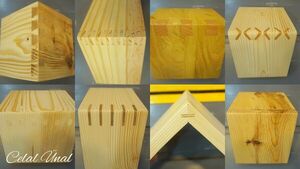2021-07-08 - Nº 323
Editorial
Esta é a Newsletter Nº 323 que se apresenta com o mesmo formato que as anteriores. Se gostar da Newsletter partilhe-a!
Todas as Newsletters encontram-se indexadas no link.
Esta Newsletter tem os seguintes tópicos:
Faz hoje anos que nascia, em 1831, o farmacêutico norte-americano John Stith Pemberton. Ele ficou conhecido por ter inventado a Coca-Cola em 1885. No início era um tónico, o vinho francês Coca. Mais tarde ele modificou a fórmula retirando o álcool e adicionando outras essências vegetais. O novo xarope destinava-se a ser uma cura segura para as dores de cabeça. A 29 de Maio de 1886, a Coca-Cola foi anunciada pela primeira vez no Diário de Atlanta. Pemberton vendeu mais tarde a receita, equipamento e maquinaria para fabricar a bebida a Asa G. Candler por $1200.
Faz também hoje anos que nascia, em 1838, o inventor, engenheiro e fabricante alemão Ferdinand von Zeppelin. Ele foi o pioneiro da aviação que construiu as primeiras aeronaves dirigíveis rígidas, chamadas Zeppelins. Depois de se reformar de uma carreira militar (1890), dedicou dez anos à concepção e construção da sua primeira bem sucedida embarcação ligeiro-ar, a LZ-1. Patenteou a sua ideia a 31 de Agosto de 1895 e formou uma empresa para a construção de dirigíveis em 1898. O seu primeiro dirigível descolou a 2 de Julho de 1900 no Lago Constança, onde tinha sido montado num hangar flutuante de montagem. O seu sucesso estimulou o financiamento por parte da comunidade. Eventualmente, ele produziu mais de 100 zepelins para usos militares na I Guerra Mundial. Durante a guerra, os zepelins foram usados para bombardear a Grã-Bretanha a partir de 19 de Janeiro de 1915 com ataques a Great Yarmouth e King's Lynn. Após a guerra, ele continuou a melhorar o projecto e construiu uma frota de dirigíveis para serviço comercial de passageiros, que incluía voos transatlânticos. O uso de Zeppelin terminou após o desastre do incêndio de 6 de Maio de 1937 em Lakehurst, N.J., E.U.A.
Faz igualmente hoje anos que nascia, em 1894, o físico russo Pyotr Kapitsa. Ele partilhou (com Arno Penzias e Robert Woodrow Wilson) o Prémio Nobel da Física de 1978 pelas suas invenções e descobertas básicas sobre campos magnéticos fortes na área da física de baixa temperatura. Ele descobriu que o hélio II (a forma estável de hélio líquido inferior a 2.174 K, ou -270.976 C) não tem quase viscosidade (ou seja, resistência ao fluxo). No final dos anos 40, Kapitza mudou o seu foco, inventando geradores de micro-ondas de alta potência - planotron e nigotron (1950-1955) e descobriu um novo tipo de descarga contínua de plasma de alta pressão com temperaturas de electrões superiores a um milhão de kelvin.
Faz também hoje anos que nascia, em 1895, o físico soviético Igor Tamm. Ele partilhou o Prémio Nobel da Física de 1958 com Pavel A. Cherenkov e Ilya M. Frank pelos seus esforços em explicar a radiação Cherenkov. Tamm foi um físico teórico notável, após pesquisas iniciais em cristalo-óptica, desenvolveu um método para interpretar a interacção das partículas nucleares. Juntamente com I. M. Frank, desenvolveu a interpretação teórica da radiação dos electrões que se movem através da matéria mais rapidamente do que a velocidade da luz (o efeito Cerenkov), e a teoria dos chuveiros em raios cósmicos. Também contribuiu para os métodos de controlo das reacções termo-nucleares.
Por fim, faz hoje anos que nascia, em 1904, o matemático francês Henri Cartan. Ele fez avanços fundamentais na teoria das funções analíticas, trabalhou na teoria das roldanas, teoria homológica, topologia algébrica e teoria do potencial. Juntamente com outros, tais como Weil e Dieudonné, Henri Cartan escreveu sob o nome de Bourbaki. Eléments de mathématique de Bourbaki contém mais de 30 volumes e pretende apresentar a matemática de modo a ilustrar a estrutura axiomática da matemática moderna.
Faz hoje 10 anos que foi lançado pela ultima vez o vaivém Atlantis. Foi a ultima vez que vaivéns da classe Space Shuttle seria lançada. Este em particular completou 33 voos depois de ter sido lançado pela primeira vez em 1985. Nesta ultima missão foi reabastecer a ISS e trazer algum equipamento danificado. Foi lançado com uma tripulação de quatro astronautas e a missão durou 12 dias e 18 horas, tendo percorrido um total de 8.505.161 km. Foi a missão nº 135 dos Space Shuttles. Esta classe de vaivéns ficou para história devido aos dois desastres com o Challenger e com o Columbia que resultaram na morte de todos os tripulantes. Foram construídos no total 5 Space Shuttles.
Nesta semana que passou os astronautas chineses a bordo da estação orbital chinesa Tianhe fizeram a primeira caminhada espacial. Estiveram a instalar câmaras e outros equipamentos fazendo uso de um braço robótico com cerca de 15 metros de comprimento. Os astronautas Liu e Tang passaram cerca de sete horas fora da estação orbital.
Também nesta semana que passou, mas em Marte, o helicóptero Ingenuity completa o seu nono voo na superfície de Marte. Este 9º voo não era como os voos que o precederam. Quebrou os recordes de duração de voo e velocidade de cruzeiro, e quase quadruplicou a distância voada entre dois locais. Mas o que realmente distinguiu o voo foi o terreno a que o Ingenuidade teve de negociar durante os seus 2 minutos e 46 segundos no ar - uma área chamada "Séítah" que seria difícil de atravessar com um veículo terrestre como o Perseverance. Este voo foi também explicitamente concebido para ter valor científico, fornecendo a primeira visão de perto dos principais alvos da ciência que o "Rover" não alcançará durante bastante tempo.
Na Newsletter desta semana apresentamos diversas noticias, artigos científicos, projetos de maker assim como alguns videos interessantes. É apresentado o livro "A Practical Introduction to Python Programming".
 João Alves ([email protected])
João Alves ([email protected])
O conteúdo da Newsletter encontra-se sob a licença  Creative Commons Attribution-NonCommercial-ShareAlike 4.0 International License.
Creative Commons Attribution-NonCommercial-ShareAlike 4.0 International License.
Novidades da Semana

Chinese astronauts install tools on first spacewalk outside new space station
"For the first time, two astronauts have worked outside of China's space station, completing only the second spacewalk in the history of the country's space program. Liu Boming and Tang Hongbo began the six-hour and 46-minute extravehicular activity (EVA) on Saturday (July 3) at 8:11 p.m. EDT (0011 GMT or 8:11 a.m. Beijing Time on July 4). Liu was first to exit the space station's Tianhe ("Harmony of the Heavens") core module, followed by Tang about three hours later. Wearing upgraded Chinese Feitian spacesuits, the two Shenzhou 12 crewmates outfitted the space station with tools needed to support future activities. Liu, initially working alone, attached a foot restraint and platform to the end of the station's 33-foot-long (10-meter) robotic arm and then mounted the arm himself. Shenzhou 12 commander Nie Haisheng then tested the arm's controls, moving Liu from inside the Tianhe module." [...]

Flight 9 Was a Nail-Biter, but Ingenuity Came Through With Flying Colors
"It has been a week of heightened apprehension on the Mars Helicopter team as we prepared a major flight challenge for Ingenuity. We uplinked instructions for the flight, which occurred Monday, July 5 at 2:03 am PT, and waited nervously for results to arrive from Mars later that morning. The mood in the ground control room was jubilant when we learned that Ingenuity was alive and well after completing a journey spanning 2,051 feet (625 meters) of challenging terrain. Flight 9 was not like the flights that came before it. It broke our records for flight duration and cruise speed, and it nearly quadrupled the distance flown between two airfields. But what really set the flight apart was the terrain that Ingenuity had to negotiate during its 2 minutes and 46 seconds in the air – an area called “Séítah” that would be difficult to traverse with a ground vehicle like the Perseverance rover." [...]
Outras Notícias
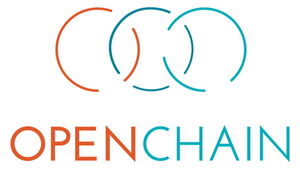
Samsung Electronics Adopts International Open Source Standard
"Samsung Electronics today announced the adoption of OpenChain ISO (International Organization for Standardization) / IEC (International Electrotechnical Commission) 5230:2020, the first international standard for open source compliance. The company joins a growing community of companies in the field of consumer electronics, automotive, cloud computing and telecommunications in using this standard to manage supply chains. The OpenChain Project began in 2016 as an initiative of the Linux Foundation, a non-profit organization in the United States. It aims to establish an effective and consistent open source compliance system. The OpenChain Project was adopted as an ISO / IEC international standard in 2020. The project evaluates each company’s open source compliance capabilities and grants certification if they met the criteria." [...]

Maxim Integrated’s Automotive Backlight Driver with Integrated Boost Converter Sustains Full, Constant Brightness of In-Car Displays Even During Cold Crank Conditions
"LED driver with four 120mA channels features industry’s lowest input voltage and highest efficiency in a single chip Maxim Integrated Products, Inc. (NASDAQ: MXIM) introduces the four-channel, low-voltage MAX25512 automotive LED backlight driver with integrated boost converter. It is the only integrated solution that retains full, constant brightness of in-car displays even during extreme cold crank conditions down to 3V input voltage. The single chip LED driver eliminates an external MOSFET and current sense resistor and integrates I2C communication to lower bill of material cost and reduce board space by 30 percent. The highly integrated LED driver includes four 120mA channels with the industry’s highest efficiency at 2.2MHz operation. Today’s automotive start-stop systems increase fuel economy, but they can challenge the power delivery system to maintain the same level of display brightness during re-start. For example, features like display illumination upon entry can be affected by cold crank situations, with the engine drawing down the car battery enough to cause the display to turn off and back on." [...]

Renesas’ New Modular IoT Development Platform Dramatically Reduces Time-to-Market and Design Complexity
"Quick-Connect IoT System Combines Modular and Standardized Hardware and Software Building Blocks for MCUs and Sensors; Solidifies Renesas’ IoT Leadership. Renesas Electronics Corporation (TSE:6723), a premier supplier of advanced semiconductor solutions, today introduced an innovative new IoT system design platform that significantly eases the prototyping of IoT systems. The Renesas Quick-Connect IoT system consists of standardized boards and interfaces, enabling designers to quickly and easily connect a wide range of sensors to MCU development boards. The new system also delivers core software building blocks that are portable between boards, greatly reducing coding requirements. As part of the Quick-Connect IoT system, Renesas has worked with Digilent, Inc. in creating a new expanded I2C Pmod Interface, Type 6A, for wider coverage and added flexibility. Renesas has standardized on the new Pmod 6A connector from Digilent for new sensor Pmods and MCU development kits." [...]

Meet the Open-Source Software Powering NASA’s Ingenuity Mars Helicopter
"Created at NASA’s JPL, the open-source flight software called F Prime isn’t just powering humanity’s first interplanetary helicopter; it’s also powering inspiration at multiple universities. When NASA’s Ingenuity Mars Helicopter hovered above the Red Planet April 19 on its maiden voyage, the moment was hailed as the first instance of powered, controlled flight on another planet. Figuring out how to fly on Mars, where the air is thin but gravity is about a third of that on Earth, took years of work. Along with the challenge of developing a craft that was up to the task, the mission needed software to make the unprecedented flights possible. So they turned to F Prime, a reusable, multi-mission flight software framework designed for CubeSats, small spacecraft, and instruments. The program was initially developed in 2013 by a team led by Tim Canham at NASA’s Jet Propulsion Laboratory in Southern California with the aim of creating a low-cost, portable, pliable software architecture option that would allow components written for one application to be reused easily in other applications and run on a range of processors." [...]

Elon Musk's Boring Company gets approval to build tunnels in Florida
"Elon Musk's Boring Company got a step closer to building another tunnel to transport people in Tesla cars, this time in Florida. On Tuesday evening, Fort Lauderdale approved a proposal from The Boring Company to build tunnels between its downtown and the beach, a route of about three miles. The dual tunnels (one to the coast, the other back) would be called the "Las Olas Loop," named for the city's beach on the Atlantic Ocean. The company's first "Loop" is in Las Vegas. Based on city council documents, The Boring Company proposed the beach tunnel (or "subsurface public transportation system") on June 21. The agenda item says Musk's proposal advances "transportation that prioritizes [s]afety and emphasizes multimodal mobility and accessibility."" [...]
Ciência e Tecnologia

New clues to why there’s so little antimatter in the universe
"Radioactive molecules are sensitive to subtle nuclear phenomena and might help physicists probe the violation of the most fundamental symmetries of nature. Imagine a dust particle in a storm cloud, and you can get an idea of a neutron’s insignificance compared to the magnitude of the molecule it inhabits. But just as a dust mote might affect a cloud’s track, a neutron can influence the energy of its molecule despite being less than one-millionth its size. And now physicists at MIT and elsewhere have successfully measured a neutron’s tiny effect in a radioactive molecule. The team has developed a new technique to produce and study short-lived radioactive molecules with neutron numbers they can precisely control. They hand-picked several isotopes of the same molecule, each with one more neutron than the next." [...]

Giving robots better moves
"MIT alumnus-founded RightHand Robotics has developed picking robots that are more reliable and adaptable in warehouse environments. For most people, the task of identifying an object, picking it up, and placing it somewhere else is trivial. For robots, it requires the latest in machine intelligence and robotic manipulation. That’s what MIT spinoff RightHand Robotics has incorporated into its robotic piece-picking systems, which combine unique gripper designs with artificial intelligence and machine vision to help companies sort products and get orders out the door. “If you buy something at the store, you push the cart down the aisle and pick it yourself. When you order online, there is an equivalent operation inside a fulfillment center,” says RightHand Robotics co-founder Lael Odhner ’04, SM ’06, PhD ’09." [...]

Lancaster scientists part of team to discover support for disputed universal truth of particle physics
"A measurement of a fundamental principle of the standard model of particle physics — lepton flavour universality — captured by the ATLAS detector at the Large Hadron Collider, is reported in a paper published in Nature Physics. The findings supersede the long-standing result from the Large Electron–Positron Collider. Our understanding of elementary particles — the building blocks of the Universe — and the electromagnetic, weak and strong fundamental forces that act between them, is formulated in the standard model of particle physics. In the theory, electrons, muons and τ leptons represent three varieties (or flavours) of an electrically charged type of elementary particle known as leptons. The standard model assumes that the strength of the couplings between leptons and the particles that mediate the weak force — known as ‘W’ or ‘Z’ electroweak gauge bosons — is independent of the lepton flavour. This long-held principle, known as lepton flavour universality, has recently been challenged by experiments at B-factories and at the LHC." [...]
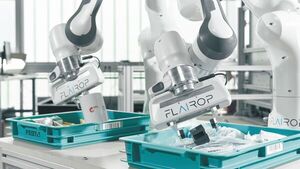
Better gripping with intelligent picking robots
"Production, warehouse, shipping - where goods are produced, stored, sorted or packed, picking also takes place. This means that several individual goods are removed from storage units such as boxes or cartons and reassembled. Researchers at the Karlsruhe Institute of Technology (KIT), together with partners from Germany and Canada, want to make picking robots smarter using distributed AI methods. To do this, they are investigating how to use training data from multiple stations, from multiple plants, or even companies without requiring participants to hand over sensitive company data. "We are investigating how the most versatile training data possible from multiple locations can be used to develop more robust and efficient solutions using artificial intelligence algorithms than with data from just one robot," says Jonathan Auberle from the Institute of Material Handling and Logistics (IFL) at KIT. In the process, items are further processed by autonomous robots at several picking stations by means of gripping and transferring." [...]

A new look at colour displays
"Researchers at Linköping University have developed a method that may lead to new types of displays based on structural colours. The discovery opens the way to cheap and energy-efficient colour displays and electronic labels. The study has been published in the scientific journal Advanced Materials. We usually think of colours as created by pigments, which absorb light at certain wavelengths such that we perceive colour from other wavelengths that are scattered and reach our eyes. That’s why leaves, for example, are green and tomatoes red. But colours can be created in other ways, and some materials appear coloured due to their structure." [...]
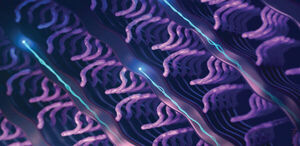
Building a better biosensor polymer
"Conquering a chemical challenge to control the structure of a polymer opens a path to better biosensors. A new organic (carbon-based) semiconducting material has been developed that outperforms existing options for building the next generation of biosensors. An international research team led by KAUST is the first to overcome some critical challenges in developing this polymer. Much research effort is currently expended into novel types of biosensors that interact directly with the body to detect key biochemicals and serve as indicators of health and disease. “For a sensor to be compatible with the body, we need to use soft organic materials with mechanical properties that match those of biological tissues,” says Rawad Hallani, a former research scientist in the KAUST team, who developed the polymer along with researchers at several universities in the U.S. and the U.K. Hallani explains that the polymer is designed for use in devices called organic electrochemical transistors (OECTs). For these types of devices, the polymer should allow specific ions and biochemical compounds to permeate into the polymer and dope it, which in turn can modulate its electrochemical semiconducting properties." [...]
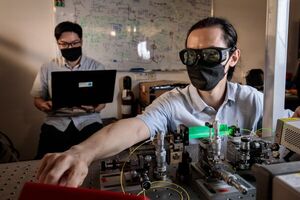
NUS researchers bring attack-proof quantum communication two steps forward
"Quantum key distribution (QKD) is a method for secure communication that uses quantum mechanics to encrypt information. While the security of QKD is unbreakable in principle, if it is incorrectly implemented, vital information could still be stolen by attackers. These are known as side-channel attacks, where the attackers exploit weaknesses in the setup of the information system to eavesdrop on the exchange of secret keys. Researchers from the National University of Singapore (NUS) have developed two methods, one theoretical and one experimental, to ensure that QKD communications cannot be attacked in this way. The first is an ultra-secure cryptography protocol that can be deployed in any communication network that needs long-term security. The second is a first-of-its-kind device that defends QKD systems against bright light pulse attacks by creating a power threshold." [...]

Why Does Mercury Have Such a Big Iron Core? Magnetism!
"A new study disputes the prevailing hypothesis on why Mercury has a big core relative to its mantle (the layer between a planet’s core and crust). For decades, scientists argued that hit-and-run collisions with other bodies during the formation of our solar system blew away much of Mercury’s rocky mantle and left the big, dense, metal core inside. But new research reveals that collisions are not to blame—the sun’s magnetism is. William McDonough, a professor of geology at the University of Maryland, and Takashi Yoshizaki from Tohoku University developed a model showing that the density, mass and iron content of a rocky planet’s core are influenced by its distance from the sun’s magnetic field. The paper describing the model was published on July 2, 2021, in the journal Progress in Earth and Planetary Science. “The four inner planets of our solar system—Mercury, Venus, Earth and Mars—are made up of different proportions of metal and rock,” McDonough said." [...]
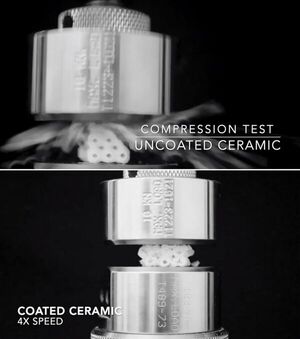
Soft shell makes hard ceramic less likely to shatter
"Rice lab shows complex, 3D-printed schwarzites withstand pressure when coated A thin shell of soft polymer can help keep knotty ceramic structures from shattering, according to materials scientists at Rice University. Ceramics made with 3D printers crack under stress like any plate or bowl. But covered in a soft polymer cured under ultraviolet light, the same materials stand a far better chance of keeping their structural integrity, much like a car windshield’s treated glass is less likely to shatter. The research at Rice’s Brown School of Engineering, which appears in Science Advances, demonstrates the concept on schwarzites, complex lattices that for decades existed only as theory but can now be made with 3D printers. With added polymers, they come to resemble structures found in nature like seashells and bones that consist of hardened platelets in a biopolymer matrix. Schwarzites, named for German scientist Hermann Schwarz, who hypothesized in the 1880s the “negatively curved” structures could be used wherever very strong but lightweight materials are needed, from batteries to bones to buildings." [...]

ITMO Scientists Discover Nonlinear Circular Dichroism in Mie-Resonant Nanoparticle Dimers
"The discovered effect may potentially be used to create special sensors for chiral molecules. These molecules are particularly useful to the pharmaceutical industry, but have a unique structure that makes them difficult to detect. The related article was published in Nano Letters. Sometimes, scientists make discoveries almost by accident: for example, when using structures intended for other experiments. The same happened when ITMO researchers managed to detect an unusual interaction between light and gallium-arsenide (GaAs) dimers – a pair of nanocylinders placed in close proximity to one another. “Prof." [...]
Tracking the rise of pixel detectors
"From their beginnings at CERN half a century ago, writes Chris Damerell, silicon pixel detectors for particle tracking have blossomed into a vast array of beautiful creations that have driven numerous discoveries, with no signs of the advances slowing down. Pixel detectors have their roots in photography. Up until 50 years ago, every camera contained a roll of film on which images were photochemically recorded with each exposure, after which the completed roll was sent to be “developed” to finally produce eagerly awaited prints a week or so later. For decades, film also played a big part in particle tracking, with nuclear emulsions, cloud chambers and bubble chambers. The silicon chip, first unveiled to the world in 1961, was to change this picture forever. During the past 40 years, silicon sensors have transformed particle tracking in high-energy physics experiments By the 1970s, new designs of silicon chips were invented that consisted of a 2D array of charge-collection sites or “picture elements” (pixels) below the surface of the silicon." [...]
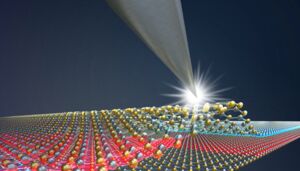
The World's Thinnest Technology - Only Two Atoms Thick
"Technological breakthrough from Tel Aviv University The innovative technology may significantly improve electronic devices in terms of speed, density, and energy consumption. Thinnest Unit Known to Science Researchers from Tel Aviv University have engineered the world's tiniest technology, with a thickness of only two atoms. The new technology proposes a way for storing electric information in the thinnest unit known to science, in one of the most stable and inert materials in nature. The technology works by using quantum-mechanical electron tunneling, which through the atomically thin film may boost the information reading process much beyond current technologies. The multidisciplinary research was performed by scientists from the Raymond and Beverly Sackler School of Physics and Astronomy and Raymond and Beverly Sackler School of Chemistry. The group includes Maayan Vizner Stern, Yuval Waschitz, Dr. Wei Cao, Dr. Iftach Nevo, Prof. Eran Sela, Prof. Michael Urbakh, Prof. Oded Hod, and Dr. Moshe Ben Shalom." [...]

Quantum particles: Pulled and compressed
"Only recently researchers have levitated and cooled nanoparticles into the quantum regime. An Austrian research team led by Oriol Romero-Isart now proposes a way to harness the quantum properties of such particles before they lose them due to decoherence. To this end, the wave function of the particle is repeatedly expanded and compressed in a loop. Very recently, researchers led by Markus Aspelmeyer at the University of Vienna and Lukas Novotny at ETH Zurich cooled a glass nanoparticle into the quantum regime for the first time. To do this, the particle is deprived of its kinetic energy with the help of lasers. What remains are movements, so-called quantum fluctuations, which no longer follow the laws of classical physics but those of quantum physics." [...]

Machine learning cracks the oxidation states of crystal structures
"Chemical engineers at EPFL have developed a machine-learning model that can predict a compound’s oxidation state, a property that is so essential that many chemists argue it must be included in the periodic table. Chemical elements make up pretty much everything in the physical world. As of 2016, we know of 118 elements, all of which can be found categorized in the famous periodic table that hangs in every chemistry lab and classroom. Each element in the periodic table appears as a one-, two-letter abbreviation (e.g. O for oxygen, Al for aluminum) along with its atomic number, which shows how many protons there are in the element’s nucleus. The number of protons is enormously important, as it also determines how many electrons orbit the nucleus, which essentially makes the element what it is and gives it its chemical properties." [...]
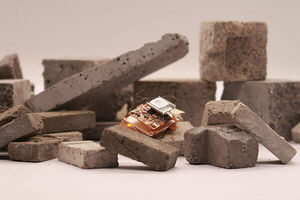
Insect-sized robot navigates mazes with the agility of a cheetah
"Many insects and spiders get their uncanny ability to scurry up walls and walk upside down on ceilings with the help of specialized sticky footpads that allow them to adhere to surfaces in places where no human would dare to go. Engineers at the University of California, Berkeley, have used the principle behind these some of these footpads, called electrostatic adhesion, to create an insect-scale robot that can swerve and pivot with the agility of a cheetah, giving it the ability to traverse complex terrain and quickly avoid unexpected obstacles. The robot is constructed from a thin, layered material that bends and contracts when an electric voltage is applied. In a 2019 paper, the research team demonstrated that this simple design can be used to create a cockroach-sized robot that can scurry across a flat surface at a rate of 20 body lengths per second, or about 1.5 miles per hour — nearly the speed of living cockroaches themselves, and the fastest relative speed of any insect-sized robot. In a new study, the research team added two electrostatic footpads to the robot. Applying a voltage to either of the footpads increases the electrostatic force between the footpad and a surface, making that footpad stick more firmly to the surface and forcing the rest of the robot to rotate around the foot." [...]
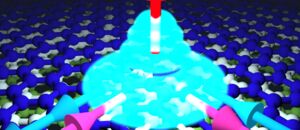
Unlocking radiation-free quantum technology with graphene
"“Heavy fermions” are an appealing theoretical way to produce quantum entangled phenomena, but until recently have been observed mostly in dangerously radioactive compounds. A new paper has shown it is possible to make heavy fermions in subtly modified graphene, which is much cheaper and safer Rare-earth compounds have fascinated researchers for decades due to the unique quantum properties they display, which have so far remained totally out of reach of everyday compounds. One of the most remarkable and exotic properties of those materials is the emergence of exotic superconducting states, and particularly the superconducting states required to build future topological quantum computers. While these specific rare-earth compounds, known as heavy fermion superconductors, have been known for decades, making usable quantum technologies out of them has remained a critically open challenge. This is because these materials contain critically radioactive compounds, such as uranium and plutonium, rendering them of limited use in real-world quantum technologies. New research has now revealed an alternative pathway to engineer the fundamental phenomena of these rare-earth compounds solely with graphene, which has none of the safety problems of traditional rare-earth compounds." [...]

Machine learning tool sorts the nuances of quantum data
"An interdisciplinary team of Cornell and Harvard University researchers developed a machine learning tool to parse quantum matter and make crucial distinctions in the data, an approach that will help scientists unravel the most confounding phenomena in the subatomic realm. The Cornell-led project’s paper, “Correlator Convolutional Neural Networks as an Interpretable Architecture for Image-like Quantum Matter Data,” published June 23 in Nature Communications. The lead author is doctoral student Cole Miles. The Cornell team was led by Eun-Ah Kim, professor of physics in the College of Arts and Sciences, who partnered with Kilian Weinberger, associate professor of computing and information science in the Cornell Ann S. Bowers College of Computing and Information Science and director of the TRIPODS Center for Data Science for Improved Decision Making. The collaboration with the Harvard team, led by physics professor Markus Greiner, is part of the National Science Foundation’s 10 Big Ideas initiative, “Harnessing the Data Revolution.” Their project, “Collaborative Research: Understanding Subatomic-Scale Quantum Matter Data Using Machine Learning Tools,” seeks to address fundamental questions at the frontiers of science and engineering by pairing data scientists with researchers who specialize in traditional areas of physics, chemistry and engineering. The project’s central aim is to find ways to extract new information about quantum systems from snapshots of image-like data." [...]
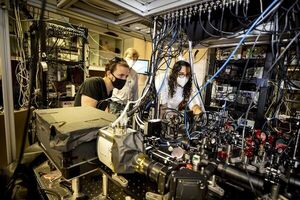
Harvard-led physicists take big step in race to quantum computing
"Team develops simulator with 256 qubits, largest of its kind ever created A team of physicists from the Harvard-MIT Center for Ultracold Atoms and other universities has developed a special type of quantum computer known as a programmable quantum simulator capable of operating with 256 quantum bits, or “qubits.” The system marks a major step toward building large-scale quantum machines that could be used to shed light on a host of complex quantum processes and eventually help bring about real-world breakthroughs in material science, communication technologies, finance, and many other fields, overcoming research hurdles that are beyond the capabilities of even the fastest supercomputers today. Qubits are the fundamental building blocks on which quantum computers run and the source of their massive processing power. “This moves the field into a new domain where no one has ever been to thus far,” said Mikhail Lukin, the George Vasmer Leverett Professor of Physics, co-director of the Harvard Quantum Initiative, and one of the senior authors of the study published today in the journal Nature. “We are entering a completely new part of the quantum world.” According to Sepehr Ebadi, a physics student in the Graduate School of Arts and Sciences and the study’s lead author, it is the combination of system’s unprecedented size and programmability that puts it at the cutting edge of the race for a quantum computer, which harnesses the mysterious properties of matter at extremely small scales to greatly advance processing power. Under the right circumstances, the increase in qubits means the system can store and process exponentially more information than the classical bits on which standard computers run. “The number of quantum states that are possible with only 256 qubits exceeds the number of atoms in the solar system,” Ebadi said, explaining the system’s vast size." [...]
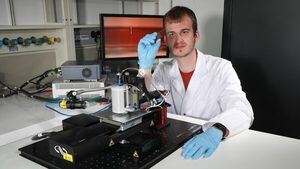
A 3D printer made entirely at EPFL
"EPFL students have made a high-performance 3D printer that can print structures measuring just a few microns across. Six months ago, EPFL professors Christophe Moser and Jürgen Brugger were in the market for a printer. But all the options were either too expensive or not up to standard. So they decided to build their own: an ultra-thin filament printer capable of printing in two and three dimensions. “We had some funding from EPFL, but we couldn’t find a melt electrowriting (MEW) printer that met our requirements,” says Moser. The pair decided to put the School’s students and engineers on the case." [...]
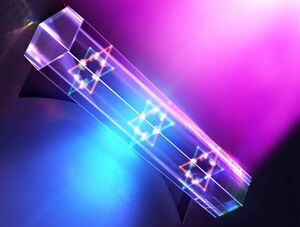
Quantum Laser Turns Energy Loss into Gain
"A new laser that generates quantum particles can recycle lost energy for highly efficient, low threshold laser applications Scientists at KAIST have fabricated a laser system that generates highly interactive quantum particles at room temperature. Their findings, published in the journal Nature Photonics, could lead to a single microcavity laser system that requires lower threshold energy as its energy loss increases. The system, developed by KAIST physicist Yong-Hoon Cho and colleagues, involves shining light through a single hexagonal-shaped microcavity treated with a loss-modulated silicon nitride substrate. The system design leads to the generation of a polariton laser at room temperature, which is exciting because this usually requires cryogenic temperatures. The researchers found another unique and counter-intuitive feature of this design. Normally, energy is lost during laser operation." [...]

Programmable structures from the printer
"Researchers at the University of Freiburg and the University of Stuttgart have developed a new process for producing movable, self-adjusting materials systems with standard 3D-printers. These systems can undergo complex shape changes, contracting and expanding under the influence of moisture in a pre-programmed manner. The scientists modeled their development based on the movement mechanisms of the climbing plant known as the air potato (Dioscorea bulbifera). With their new method, the team has produced its first prototype: a forearm brace that adapts to the wearer and which can be further developed for medical applications. This process has been collaboratively developed by Tiffany Cheng and Prof. Dr. Achim Menges from the Institute of Computational Design and Construction (ICD) and the Integrative Computational Design and Construction for Architecture Cluster of Excellence (IntCDC) at the University of Stuttgart, together with Prof. Dr. Thomas Speck from the Plant Biomechanics Group and the Living, Adaptive and Energy-autonomous Materials Systems Cluster of Excellence (livMatS) at the University of Freiburg. The researchers are presenting their results in the journal Advanced Science." [...]
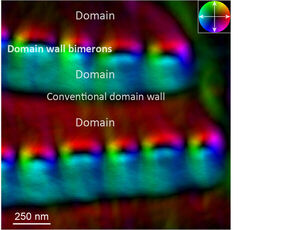
Scientists observe a new type of topological defect in chiral magnets for the first time
""Topological defects" are formed when the symmetry of a magnetic material is disrupted. Domain walls (DWs) are a type of topological defect that separates regions of different magnetic orientations. A widely studied phenomenon, the manipulation of these defects has potential applications in high-performance memory storage devices, energy processing devices, and quantum computing. Recently, the possibility of other topological defects embedded in or combined with DWs has gained attention for their potential applications in different fields of physics. Some examples of these "defects within defects" called DW skyrmions and DW bimerons. While theoretical models have supported the existence of these defects, they have not been experimentally observed -- not before now." [...]
Ultrathin semiconductors electrically connected to superconductors for the first time
"For the first time, University of Basel researchers have equipped an ultrathin semiconductor with superconducting contacts. These extremely thin materials with novel electronic and optical properties could pave the way for previously unimagined applications. Combined with superconductors, they are expected to give rise to new quantum phenomena and find use in quantum technology. Whether in smartphones, televisions or building technology, semiconductors play a central role in electronics and therefore in our everyday lives. In contrast to metals, it is possible to adjust their electrical conductivity by applying a voltage and hence to switch the current flow on and off. With a view to future applications in electronics and quantum technology, researchers are focusing on the development of new components that consist of a single layer (monolayer) of a semiconducting material." [...]

Nanomaterials shape and form influences their ability to cross the blood brain barrier - study
"Nanomaterials found in consumer and health-care products can pass from the bloodstream to the brain side of a blood-brain barrier model with varying ease depending on their shape – creating potential neurological impacts that could be both positive and negative, a new study reveals. Scientists found that metal-based nanomaterials such as silver and zinc oxide can cross an in vitro model of the ‘blood brain barrier’ (BBB) as both particles and dissolved ions - adversely affecting the health of astrocyte cells, which control neurological responses. But the researchers also believe that their discovery will help to design safer nanomaterials and could open up new ways of targeting hard-to-reach locations when treating brain disease. Publishing its findings today in PNAS, an international team of researchers discovered that the physiochemical properties of metallic nanomaterials influence how effective they are at penetrating the in vitro model of the blood brain barrier and their potential levels of toxicity in the brain. Higher concentration of certain shapes of silver nanomaterials and zinc oxide may impair cell growth and cause increased permeability of the BBB, which can lead to the BBB allowing easier brain access to these compounds. The BBB plays a vital role in brain health by restricting the passage of various chemical substances and foreign molecules into the brain from surrounding blood vessels." [...]

Quantum machine learning hits a dead end in a black hole
"A new video explains the theorem developed at Los Alamos National Laboratory showing that information run through an information scrambler such as a black hole will reach a point where any algorithm will be unable to learn the scrambled data. “Our theorem implies that we are not going to be able to use quantum machine learning to learn typical random or chaotic processes, such as black holes. In this sense, it places a fundamental limit on the learnability of unknown processes,” said Zoe Holmes (CCS-3, Information Sciences), a post-doc at Los Alamos National Laboratory and coauthor of the paper describing the work published today in Physical Review Letters. Watch the video for a quick overview of the research from everyone’s favorite quantum explainers, Alice and Bob. Does a black hole hide all secrets? In a classic quantum-science thought experiment, Alice throws a book of secrets into a black hole." [...]

Pop-up coffee table — no assembly required
"Kiriform structures harness buckling for stable, deployable structures Deployable structures — objects that transition from a compact state to an expanded one — are used everywhere from backyards to Mars. But as anyone who has ever struggled to open an uncooperative folding chair knows, transforming two-dimensional forms into three-dimensional structures is sometimes a challenge. Now, researchers from the Harvard John A. Paulson School of Engineering and Applied Sciences (SEAS) and the Harvard Graduate School of Design have developed a deployable system that is light, compact, inexpensive, easy to manufacture, and, most importantly, easy to deploy. By harnessing the mechanical instabilities in curved beams, the system can transform objects into elaborate and customizable 3D configurations on a range of scales, from large-scale furniture to small medical devices. “Most buckling-induced deployable structures, like folding chairs, are activated by compressive forces that are created through the linear displacement of elements,” said Saurabh Mhatre, a research associate at GSD and first author of the paper. “Our approach is different in that the compression force is generated through a rotational movement, which in turn induces buckling as the trigger for the 2D-to-3D transformation.” The interdisciplinary research team of designers and engineers used a combination of experiments and numerical analyses to understand the geometry of curved, slender beams and what happens when those beams rotate and buckle." [...]
Documentação
A documentação é parte essencial do processo de aprendizagem e a Internet além de artigos interessantes de explorar também tem alguma documentação em formato PDF interessante de ler. Todos os links aqui apresentados são para conteúdo disponibilizado livremente pelo editor do livro.

A Practical Introduction to Python Programming
"This book started out as about 30 pages of notes for students in my introductory programming class at Mount St. Mary’s University. Most of these students have no prior programming experience, and that has affected my approach. I leave out a lot of technical details and sometimes I oversimplify things. Some of these details are filled in later in the book, though other details are never filled in. But this book is not designed to cover everything, and I recommend reading other books and the Python documentation to fill in the gaps. The style of programming in this book is geared towards the kinds of programming things I like to do—short programs, often of a mathematical nature, small utilities to make my life easier, and small computer games." [...]
Projetos Maker
Diversos Projetos interessantes.
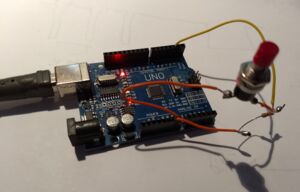
Arduino Morse Code
"This is an Arduino program that decodes Morse code from an I/O pin. " [...]

DIY Raspberry Pi Pico Starter Shield
"In this instructable, I will show you how to build Pi Pico Starter Shield a shield that will help you learn and make projects Pi Pico easier and faster. Let's get started! Here are the components that you will need to make Pi Pico Starter Shield: 1 x PCB Pi Pico Starter Kit (PCBWay) 1 x Raspberry Pi Pico board 1 x I2C Character LCD 16x2 1 x Motion sensor PIR AM312 1 x LDR (Photoresistor) 3 x LED 5mm (Red, Green, Yellow) 1 x RGB LED 8mm WS2812 1 x Active BUzzer 2 x Tact Switch 6x6mm 1 x Potentiometer 10K Ohm 3 x Resistor 330 Ohm 1 x Resistor 10K Ohm 4 x M3 10mm Set Spacer Screw 2 x Female Header 20 pin 1 x Male Header 4x20pin, pin, 4x3pin & 5pin 1 x Double Male Header 2 pin 1 x Slide Switch 2 x Jumper cap" [...]
Easy Light Tracking Device
"Light tracking made easy with Arduino As a part of the learning process, I picked up the light tracking topic using Arduino. Watched few YouTube videos and articles and I started my own project with my own algorism. Luckily, my Light Tracking Gimbal is able to move smoothly towards the light source and hold its position while light source is not moving. " [...]
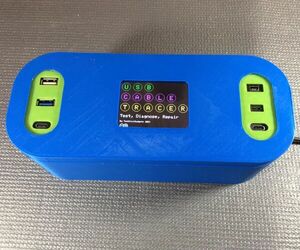
Arduino Cable Tracer
"Instantly diagnose the type and integrity of USB cables with this Arduino Cable Tracer. Suitable to trace USB A, Mini, Mico, and USB-C cables this is very useful to identify the exact wiring configuration and also diagnose broken connections. The Arduino Mega board is an excellent option for this project because it can support both a display and provide an additional 48 digital pins to simultaneously trace each of the wires within a cable. For this prototype, I used existing cables with commonly used USB sockets. Parts list Arduino Mega 2560 board USB A to USB B Arduino Mega programming cable 2.8" TFT LCD display Vero Board (1 of 16x6 holes, 2 of 8x5 holes, 2 of 17x5 holes - see photo) Arduino dual strip male header pins( 2 of 8 pins, 2 of 6 pins - see photo) Arduino Stackable Header 4 of 8 pins Vero Pins qty of 48 2 x USB-C V3.0 Cable 2 x USB-C to USB-C through adapter 2 x USB Mini to USB A adapter 1 x USB Micro cable with socket 1 x USB-A cable with socket 1 x USB-A V3 cable with socket Tools Access to a 3D printer with a Build Plate of 220mm (i.e Creality Ender 3) Soldering Iron Box cutter knife Metal Ruler Wooden chopping board Heat Shrink insulation Wire Strippers Heat shrink air gun Hot Glue Gun Electronic PCB microscope (optional if you have issues with cable wiring)" [...]
Neopixel LED Skirt (motion Triggered)
"After searching for quite a while for a joint project together with my girlfriend, who is a pro in sewing, we finally made this Neopixel skirt together and it came out great. So it's time to share it with the instructables community. The skirt has the following features: - 120 addressable LEDs arranged in 6 vertical strips (20 each) - all LEDs are controllable with only one data pin by an Arduino controller - 6-axis motion sensor to detect movements and rotations - powered by a USB battery pack for full day usage - Electronics are invisible when turned off - only LEDs installed at the front of skirt to make it daily usable (sitting, driving, etc. )" [...]
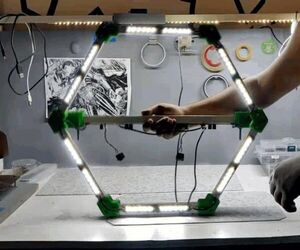
HEXLight, a DIY Studio Light Alternative
"Hey everyone What's up! So this is HEX Light which is a DIY Studio Lighting Setup that consists of a total of 72 High Power Cree LEDs and they are powered by a 12V 5A SMPS. LEDs are driven by two separate LED Driver ICs and this whole setup cost less than 100$ to make which is still cheaper than other similar size studio light available in the market. Also, huge thanks to PCBWay for Supporting this project, Check out PCBWay for getting great PCB Service at a relatively less cost. Question, why did I make this huge studio light? Well, the answer here is pretty simple, I required a proper lighting setup for my current maker setup and all I have were few LED Strips and a small studio lightbox that I recently made, they all were functional but not exactly great." [...]

Voltage-Controlled Pulse Width Modulator (PWM) – PWM Signal Generator
"This is an easy-to-use voltage to PWM converter. The project occupies very little space. The circuit is built using the versatile silicon timing device LT6992-1 chip. Pulse Width Modulation (PWM) Controlled by Simple 0V to 1V Analog Input, multiturn trimmer potentiometer provided to adjust the duty cycle 0 to 100 %. The circuit also has provision to set the frequency to 2.65Khz, 7.8Khz, 10.7Khz or 15.7Khz using jumper J1 and J2. Circuit operates with a 5V Supply." [...]
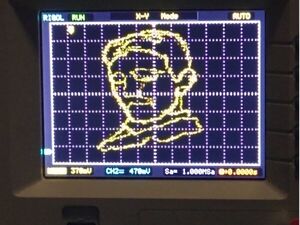
Draw Anything on Your Oscilloscope
"Ever wanted to display any hand-drawn image on your fancy oscilloscope? Well, now you can! The R-2R DAC One of the simplest implementations of a digital to analog converter can be achieved by designing a R-2R ladder DAC. This type of DAC only needs resistors to work making it a very beginner-friendly DAC. The basic principle of this type of DAC is that you just need two values for resistors. R and 2R." [...]
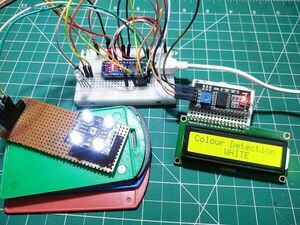
Color Detector Using Arduino and TCS 230
"Hello there, do you want to make your own Color Detector Using Arduino and TCS 230 Color Sensor. If so, you have come to the right destination. In this article, we will learn how the TCS 230 Color Sensor works with Arduino. In this project, we use TCS 230 sensor to detect the color and a 16X2 LCD to display the name of the color. We use five LEDs of different colors so the LED of the detected color will glow automatically. You can also use an I2C module for interfacing the LCD with Arduino." [...]
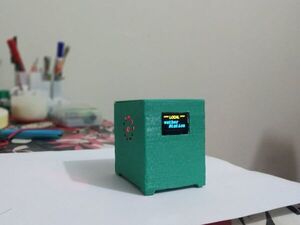
Local Weather Station
"A weather station that can show local atmospheric pressure, temperature humidity and UV index without any internet connection. For a long time, I wanted to make a weather station without using the internet. It is great to measure the weather data on your surrounding and take a look at the data when wanted. so, I make a cool-looking local weather station that can measure your surrounding air pressure, temperature, humidity, and the UV index of the day (if you place it near the window). Wait it has more! 😉 it also has a Clock screen for showing Time, date, and day of the week." [...]
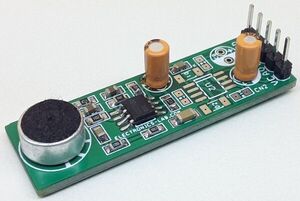
Microphone Preamplifier – Sound Sensor
"This is an easy to construct dual-stage microphone pre-amplifier. The project can be used as a sound sensor or microphone pre-amplifier. The 1st op-amp pre-amplify the very low-level signal coming from the condenser microphone and 2nd op-amp provides more boost to the audio signal. The pre-amplifier is an important building block for many audio communication systems and sound sensors. The circuit has been built around OPAMP LM358. The output signal level is dependent on the input sound level." [...]
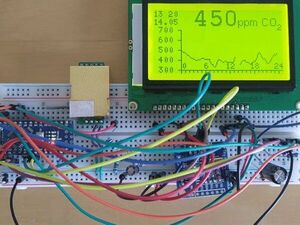
CO2-Monitor
"A small Monitor that displays the progression of the CO2-concentration within one day. If you stay in a room or simply if you light a candle, the CO2 concentration will rise as the air quality decreases. There are a lot of air quality monitors giving a number of even a signal indicating that it is time for ventilation. This monitor shows the CO2 protocol of the last 24 hours to see all effects that influence the air quality. So you can e.g. observe the totally different effects of ventilation at windless or breezy days." [...]
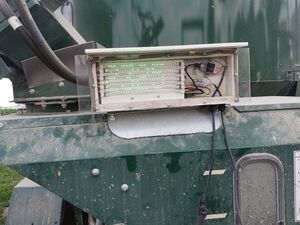
Roller Mill Remote Scale Display
"A practical use of the M5Stack Atom RS232 as part of a remote display. Goal This project came about after pricing commercially available remote displays for our roller mill. We wanted a display at the front of the mill so that the operator could see the weights from the both the tractor seat and be large and easy to read in the dark. Reasoning Displays that are available and compatible for our the scales were more expensive than we really wanted to pay. I decided to use my limited programming knowledge and the experiences I have had with microcontrollers in past projects to come up with a solution. Hardware I decided to base the project around the ESP32 module." [...]
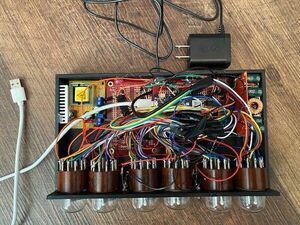
Multiplexed Nixie Tube Clock
"Less expensive and easier to build than some other Nixie clocks. Displays seconds, blinking colons, and it sets itself using WiFi! Introduction Nixie tubes are quite popular with electronic hobbyists lately. They are an antique novelty! I am one of the few among us who is old enough to remember when Nixie tubes were state-of-the-art displays back in the 1960s and early 70s. They disappeared almost instantly with the arrival of LED displays!" [...]

Led Matrix Clock using Arduino And RTC Module
"Today iam going to show you how to make led matrix clock With Arduino & Rtc. this is a simple project does not require high knowledge Today iam going to show you how to make led matric clock With Arduino & RTC Module. this is a simple project does not require high knowledge about arduino and electronics this is an intermediate level project, so its kind of okay to you. I tried my best to document this project to you, to look simple. so you can also make this project as I do, if you appreciate my work, a sub to my youtube channel will make me happy and keeps me motivated so I can make new projects for you in the near future, so with out further ado lets get started........" [...]

Ohm Clock
"A clock that shows the time using the resistor color code. With a built-in auto-ranging ohm meter, you can set the time with a resistor. This clock is shaped like a big resistor and shows the time by lighting up the bands with the equivalent resistor color code. Setting the time The clock supports setting the time using a pair of buttons or by reading the value of an actual resistor placed on its two terminals. The two buttons are SET and NEXT. Pressing the SET button will cause the Hours - Ten and Hours - Units bands to flash." [...]

IoT based Door Security Alarm Project with Blynk
"Today security is one of the prime aspect in our society. Securing our home and family is important. In this article we will see how to make a IoT based Door Security Alarm using Blynk. Today security is one of the prime aspect in our society. Securing our home and family is important.This is a simple but effective door security system. Parts List This project requires simple components and modules." [...]
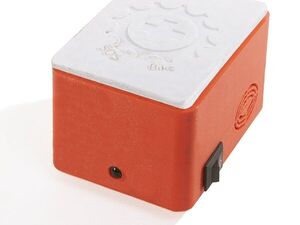
SOS bike alarm
"Protect your bike from thefts with an alarm. you can do it. the SOS alarm, comes in my mind for a device that help people avoid bikes thefts. This is a simple alarm system made with help of buzzer, LED and a motion detector. One can stop the buzzer by pressing the button. The setup is now ready." [...]
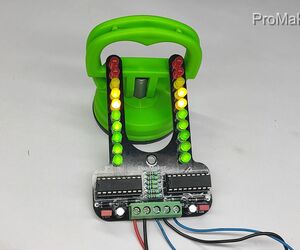
How to Make Stereo VU Meter
"In this project, i will show you how to make a simple & easy Vu Meter or Audio Meter using LM3915. What is a VU meter circuit? A VU meter is also an audio Visualizer that has a group of LEDs as dot or Bar display. VU meters are basically used with the Amplifiers and audio systems to analyze and display the audio spectrum. The LED dot or bar display lights up LEDs-high to low showing the level of the pitch with matching the pattern of bass going high or low. Here in this article, I am going to discuss a VU meter Circuit using the LM3915 IC." [...]
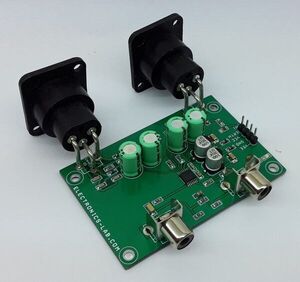
Stereo Balanced to Unbalanced Audio Converter
"The primary role of this project is to convert a differential input audio signal into a single-ended output signal while rejecting noise that is common to both inputs (common-mode noise). The circuit presented here is a differential amplifier intended to receive balanced line inputs in audio applications requiring a high level of noise immunity and optimum common-mode rejection. The circuit typically achieves an extremely high common-mode rejection ratio (CMRR) of 91 dB while maintaining an ultra-low THD+N of –120 dB at 1 kHz for 22-dBu signal levels. Precision matching of on-chip resistors gives the circuit an excellent CMRR performance. Operating supply range +/-12V to +/-15V. Connection of a stereo balanced line input via 2 x female XLRs to a stereo unbalanced output on RCA connectors." [...]
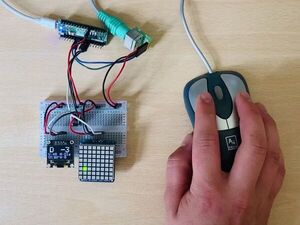
Arduino MIDI Mouse Controller
"Turn an old "roller ball" mouse into a MIDI controller that can unlock new ways of making digital music. Reimagining MIDI devices based on old electronics I hate throwing away old electronics that still work but are no longer supported by modern appliances. My idea for this project came after finding an old PS/2 port roller ball computer mouse that I no longer had a use for. I'm a musician in my spare time and currently recording an EP with my metal band HELL SHEEP. I'm using MIDI controllers to create synth parts for our tracks on pro tools. Many people use a MIDI keyboard to write MIDI parts on the computer." [...]

Measure with Music: How to Read Analog Sensors Using a PC Sound Card
"This post describes a simple method of reading resistive and capacitive sensors using a standard PC sound card. Virtually any desktop or laptop could be turned into a simple data acquisition system using this method. Thanks to moderate system requirements, even the very old computers can be repurposed for this application. Socket 478 based platforms from early 2000’s with integrated sound cards are readily available for ~free from recycling bins and are perfectly capable of running the data acquisition software (thankfully, Debian still supports 32-bit platforms). With the total cost of other components under $1, this can hopefully bring affordable and interactive data acquisition to DIYers, experimenters and students in science and physics classes. I do not recommend (in fact, I highly discourage) using this method for anything but educational purposes." [...]
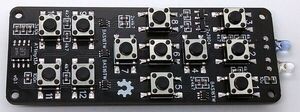
TinyRemoteXL - 12-Button IR Remote Control based on ATtiny13A
"TinyRemoteXL is a 12-button IR remote control based on an ATtiny13A powered by a CR2032 or LIR2032 coin cell battery. The basic hardware is similar to the 5-button TinyRemote. The main difference is that the ATtiny13 has to query 12 buttons here. There are various options for using a larger number of buttons with just a few pins. However, most of them do not meet the following conditions: there are only four pins available for twelve buttons, a keystroke must trigger an asynchronous interrupt to wake the ATtiny from deep sleep mode, the circuit must not consume any electricity as long as no button is pressed. " [...]
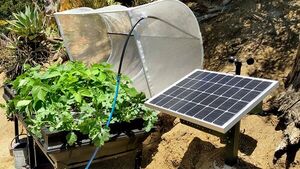
MicroPython Vegetable Garden Automation Tutorial
"This project adds solar powered sensors and home automation to my vegetable garden and transmits the data using MQTT for review and control on a mobile app. The canopy protects the vegetables from deer, squirrels and other pests. It also reduces weeds and mitigates harsh weather. Yet the permeable canopy doesn’t block sun light, rain or fresh air. There are 4 pods that utilize a wicking system to water the plants from below. Underneath the platform in each pod is a reservoir." [...]
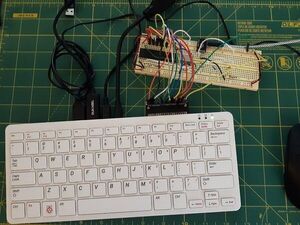
AY-3-8910 Speech Synthesis
"A Python library to control a General Instrument AY-3-8910 sound generator from a Raspberry Pi. To demonstrate the abilities of the chip, I used it to synthesize speech. This sound chip was first produced in 1978, and was in arcade and pinball games, the Intellivision and Vectrex game consoles, and in sound cards for the Apple II and TRS-80 Color Computer. " [...]

MQTT ESP8266 Home Automation Project 2021
"How to make MQTT ESP8266 NodeMCU Home Automation project to control relays from the switch and smartphone (Circuit + Code) through internet. In this IoT project, I have shown how to make an MQTT ESP8266 Home Automation project to control a 4-channel relay module from the manual switch & smartphone. This NodeMCU ESP8266 control smart relay has the following features: 1. Control home appliances through the internet. 2. Control home appliances manually with pushbuttons." [...]
Secção Videos
Videos interessantes.
That's all Folks!





